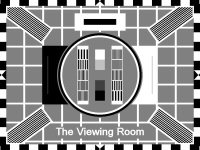
Northsea Television
North Sea Oilfield 1972 - 1974
Introduction
Perhaps the most remarkable franchise in the whole history of the ITV network came as the result of - of all things - an exposť in the News Of The World.
Early in 1972, the intrepid muckraker sent a couple of its crack reporters undercover in the newly developing North Sea oil and gas industry. Rigs and platforms were sprouting above the grey waves of that body of water, and lurid tales were filtering back to shore about some of the things that were going on during the workforce's off-duty hours. So, ever eager to be outraged on its readers' behalf, that thrusting organ dispatched two likely hacks to find out the truth, and to make it up if they couldn't find anything.
"VICE AND DEBAUCHERY IN BRITAIN'S NEW KLONDYKE!", screamed the headline over the eventual story. In it, the paper claimed that off-duty oil and gas platform workers were indulging in Saturalia involving raunchy 8mm films and even that (dare one say it) str*pp*rs were being flown to the rigs for the amusement and relief of the isolated he-men.
As a result, questions were asked in The House, and for the Heath government, with municipal and other scandals lapping at its kneecaps, it was obvious that something had to be done. The Postmaster General got on to the IBA. "Couldn't you provide a safe, regulated service to these men?", he asked. "Leave it out!", retorted the Brompton Road College Of Cardinals. "What with? We're not a licence to print money, you know!"
But the PMG persisted, and the IBA was persuaded to look into the possibility as a matter of the highest urgency.
| And so it was that, on the evening of 14th September 1972, this appeared on the screens of the television sets which had been donated to the rigs by Philips. It was quite a plain and unadorned picture, but the centrepiece was an inventive and effective use of a night-time shot of a drilling platform. This was to become the mainstay of all of Northsea Independent Television's idents during its short life. | 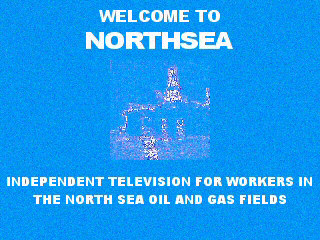
|
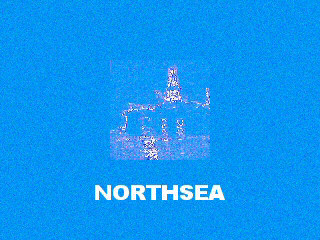
|
At 6 p.m., this appeared. Firstly the blue screen, then the central image was faded up to maximum, followed in turn by the company name fading up beneath it. It looked pretty good for something produced on an extremely limited budget. |
| The budget for the company was so limited, in fact, that it couldn't run to announcers - not even out-of-vision ones. So menus such as this (from near the end of the service's life) were a mainstay of gluing the programmes together, as there was no advertising either. | 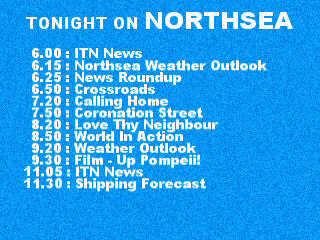
|
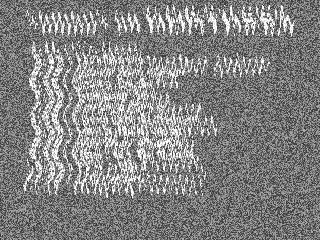
|
Of course, there were technical problems. Inevitably, with the signal being bounced across from Durris to the nearest platform with a receiving aerial before being sent on to the other rigs, reception was often at the mercy of Neptune, the ionosphere and dragging anchors. So, often, all that would be seen by the avid spectators in mid-ocean was this. |
| In which case, copies of this caption were kept on some of the platforms in the chain to ensure that the viewers were kept informed, and to give them time to set up the 8mm movie projectors again. | 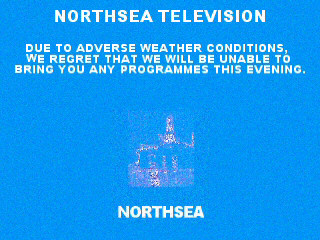
|
But how, with limited budgets and no
advertisements, could the service run? Well, having been given the
command, the IBA set up the company itself, using the precedent
of the 1968 ITV service it had organised to fill the gap between
TWW and HTV. However, to try to ensure that it couldn't be implicated
in any queries regarding political influence, it effectively sub-contracted
programme provision to a non-profit joint venture involving Grampian,
Tyne-Tees and Yorkshire.
Grampian were quite keen to identify themselves with yet another
service to the burgeoning oil economy in its region; Tyne-Tees
weren't all that eager, as it saw that their Scottish colleagues
would probably reap any benefit which would accrue from it; and
Yorkshire weren't at all happy with the arrangement, but eventually
rationalised their participation by quietly hoping that their
junior partner in Trident would be the fall-guys for them.
So it was that, apart from the ordinary network
programming which would be provided as it was to the other
regions (although often time-shifted back by at least ten
minutes), these three companies would provide specialised
programmes to Northsea.
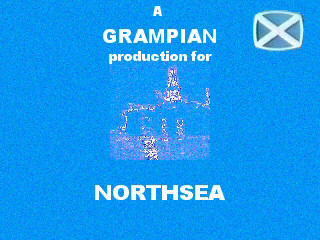
|
Unusually for that time, there were no company frontcaps on these programmes, although there were endcaps for each of the three provider companies. This one was for Grampian (who provided mostly news and weather). |
| This for Tyne-Tees, who provided religious and documentary output. | 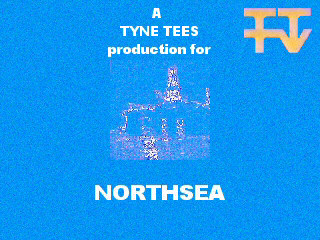
|
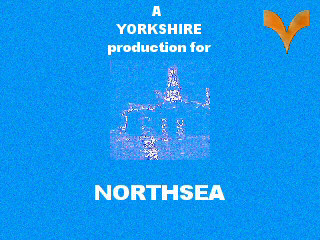
|
And this for Yorkshire, who provided everything else. |
The three companies did pool resources however, mostly for a programme called Calling Home, which relayed messages of a "Family Favourites" nature from the rig workers to their families (and vice versa). After this nightly programme, a standard Northsea ident would form the endcap.
| The weather was of prime importance to the guys out on the rigs, and so Grampian would transmit emergency captions out whenever needed. If conditions made it impossible, there was a small caption generator stationed on some of the platforms so that these could be produced locally. This is one from January 1973. | 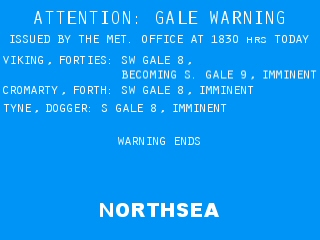
|
Such a service, dubbed "OilTV"
by the press, was never likely to survive more straitened economic
circumstances. So it was that when, irony of ironies, the oil crisis
following the 1973 Arab-Israeli war led to a major recession, the
participating companies complained bitterly to the IBA about the
expense of their involvement in Northsea. It had been termed a 'non-profit'
venture, and this had proven to be the case.
The IBA passed the buck...erm, sorry...passed these complaints
on to the Postmaster General, who was about to tell all the broadcasters
that they must close down and go to bed at 10.30 p.m. like good little
kiddies in order to save fuel in the face of the Three-Day Week.
The PMG bit the bullet, and announced to a rowdy House Of Commons
in December 1973 that Northsea Independent Television would close
the following month.

|
And so it did. On the evening of January 19th 1974 at 11.45 p.m., after the final shipping forecast, this still caption appeared. It remained on screen until five seconds to midnight, then faded to black. Northsea Independent Television had finally sunk beneath those cold, grey waves. |